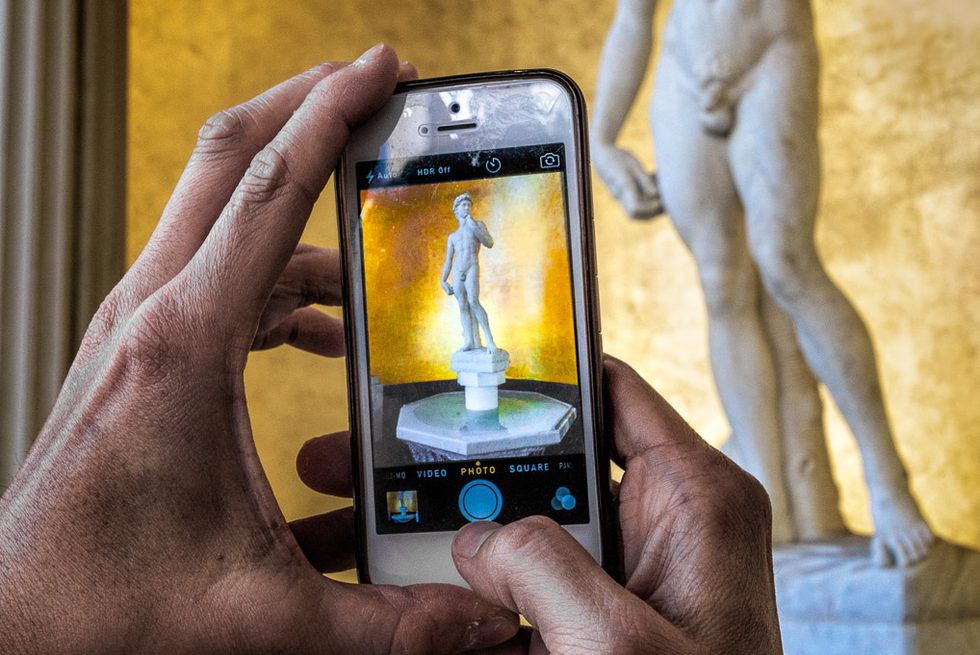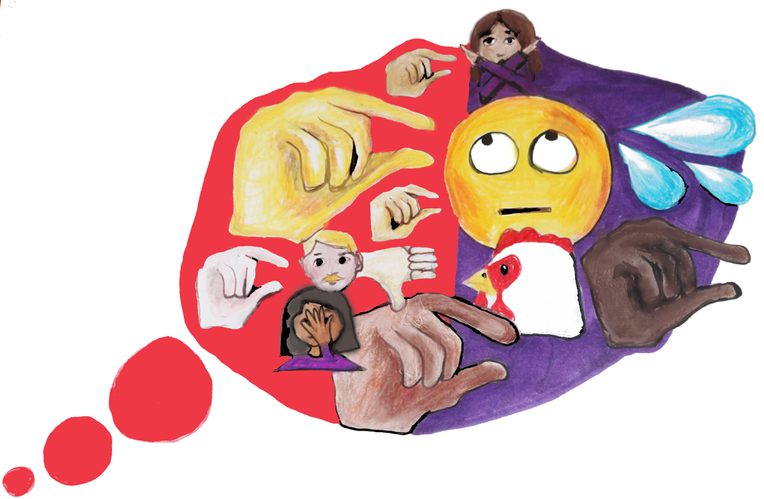
Sitting down to write my first lecture for an interdisciplinary first-year course I'd been assigned, I stare blankly at its title—Cultures and Diversity—trying to figure out where to start. I start thinking about the radio program I listened to the day before about the recent release of Unicode’s new emojis. Making greater forays than ever before into issues of representation, this set of emojis includes a variety of differently abled bodies, extends the five skin-tone options previously available for individual faces to couples (including, for the first time, a gender-neutral couple), and adds other culturally and geographically specific symbols such as a disembodied sari, a Hindu temple, and an auto rickshaw. With these developments in mind, I began writing my lecture:
I want to begin this course by asking you to recognize that we live in a culture where using little yellow heads with disproportionately large eyes and no teeth to represent our emotions about anything from last night’s pizza to breaking up with a boyfriend is totally normal. We share these visual representations of our emotions, often (but not inevitably) accompanied by words, on both private and public platforms, sometimes with not much discernible difference in usage. I want to start the course by centering this fact because I want you to bring it to mind every time we encounter a cultural practice that you think might be a little bit weird, odd, or even wrong. I want you to stop and ask yourself: what about the emojis? And then I want you to think about the emoji that some think will make the biggest splash of 2019: the small-penis emoji.

I want us to begin this class by recognizing that we live in a culture where a tiny cartoon hand gesture can be used to undermine people (predominantly those who have penises) by way of reference to their genitals, body parts that most likely we have never and will never see. I want you to recognize that in order for this to appear as natural as it likely does to those of us who use emojis, there are so many things that we need to know about this small-penis-emoji culture in which we find ourselves.
We need to understand that in this culture, to have a small penis is to be invalidated as a man and thus as a human, because in small-penis-emoji culture we rely heavily on gender performances to render ourselves legible to one another. We need to know that in small-penis-emoji culture, ideas of masculinity are linked to ideas of sexual prowess. Yet these ideas are not necessarily about sexual prowess in relation to existing or potential sexual partners, but about perceived sexual prowess among men based on ideas of masculinity that equate size with power, strength, and stamina.
We also need to know that in small-penis-emoji culture, women have historically been considered weak, passive, and emotional. In order to avoid being mistaken for a woman or a gay man—because, in this culture, ideas of gender are intertwined with ideas of sexuality—men are required to constantly perform their power and strength, as well as other traits such as rationality and independence that mark them as distinct from women. We need to recognize that this requirement to perform feats of masculine strength often has deadly consequences, such that in the corner of small-penis-emoji culture where we live, a nation known as Australia, on average one woman a week is murdered by a current or former partner.
It is important for us to recognize that these ideas about masculinity have violent histories linked to colonization and dispossession. That they have been used historically as the basis for racial arguments about the evolutionary stages of humanity and have formed the foundation of debates about the civilizational capacity of other parts of the world. We need to see that these ideas have been used to justify colonization and that they continue to justify interventions into the lives of cultural others all around the world, including here at home. Somewhat ironically, we value diversity enough to make this cartoon gesture available in a range of skin tones. Yet we need to ask ourselves: what does diversity mean in this context?
We need to understand that small-penis-emoji culture is connected and, in large part, sustained by a thing called the internet. That people in this culture often prefer to spend their time staring at screens large and small, scrolling through feeds of text and images from the lives of people they barely know, rather than actually speaking to the people around them. This scrolling is occasionally interrupted to get into long, protracted arguments about some of the above issues (gender, race, power, and history), sometimes punctuated by symbols such as the small-penis emoji. Depending on the context of its deployment, we might ask, could the small-penis emoji have the potential to bolster the credibility of an argument—or even to enact racial justice? Could the five options be used together to signal an inclusivity that resists racial stereotypes about penis size? Perhaps particular combinations could be used to draw attention to and critique, rather than reinforce these stereotypes?
Before we abandon the small-penis emoji as a symbol of a distasteful, backward, and barbaric culture, we must consider the potential for it to be used by those who are otherwise marginalized—people such as women, nonwhite, trans, intersex, and gender-nonconforming folks, and so on—as a “weapon of the weak” (Scott 1985). We must recognize the possibility for agentive and subversive uses of the small-penis emoji that challenge the very basis of small-penis-emoji culture itself. We would also do well to consider the possibility that someone may use the small-penis emoji with pride. Whether you think small-penis-emoji culture can be brought down by the small-penis emoji itself is no doubt revealing of your personal political leanings, but it is important to recognize that with this, as with all cultural symbols, meaning is not fixed or predetermined. We think we know what the small-penis emoji means, but do we really?
So, again, if you find yourself wondering about a cultural practice that seems strange to you, just stop, breathe, and bring the small-penis emoji to mind.
Rather than begin with a cultural practice that is "strange" to students and try to convince them of the ways this practice is situated within a cultural world, this activity—by taking something that is familiar— encourages students to engage with the cultural architecture that makes this familiarity possible.
In-Class Activity
Part One: As a class, brainstorm as many possible meanings of the small-penis emoji as you can, and identify the cultural knowledge required to interpret these meanings. One possible way of doing this would be to have each student in the class compose a status/tweet (with a limit of 280 characters) that includes the small-penis emoji in a range of skin tones. Students could post their status/tweet to an online discussion forum, which could then be used as the basis for a discussion about the multiplicity of meanings attached to this symbol. Engaging students in acts of interpreting each other's statuses/tweets should also highlight the diversity of ways of reading and attributing meaning to this symbol.
Part Two: Divide the class into three groups, and assign each group a specific task:
- Group 1: As members of the small-penis-emoji culture, develop a justification for the continued use of this symbol, despite its links to multiple domains of violence.
- Group 2: Design a program to rescue and provide education about the small-penis emoji, despite the violence of this symbol and all that it represents.
- Group 3: Offer a subversive reading of the small-penis emoji and a plan for its use as a symbol of resistance in the fight against the multiple violences of masculinity.
Part Three: Reflect as a class on the limits of these three approaches (rehabilitation, rescue, resistance) to understanding culture. Ask questions about what is lost and gained in each of these approaches, noting any particular overlaps, omissions, or erasures.
The activity can be paired with one or more of the following suggested readings to bring particular questions into focus:
Reflecting on R. W. Connell’s (2005) work on the intersections of gender and race, ask students to question whether their responses to any of the three approaches discussed in the activity change if we foreground a darker skin–tone version of the small-penis emoji. If so, then why and to what end?
Drawing on arguments raised by Sylvia Yanagisako and Carol Delaney (1995), ask students to what extent ideas about reproduction inform their reading of the small-penis emoji.
Elizabeth Povinelli (1994) describes how the response by Aboriginal people to the display of a white man’s genitals was laughter. Given the argument that discourses about sexuality became a means of maintaining power in the Australian context, to what extent can we regard laughter as a tool to produce, preserve, or defend other ways of being, knowing, and existing in the world?
Reflections on Playful Pedagogy
The value of this kind of pedagogy is its ability to reveal the depth of cultural meanings that are encoded in seemingly light and humorous forms of electronic communication. This exercise seeks to unsettle, trouble, and make strange what has become a fairly ubiquitous form of communication. Additionally, by encouraging students to argue for a position of rehabilitation, rescue, and resistance in relation to the small-penis emoji, the activity provides ways for students to recognize both the value and the limits of these common approaches to culture. Rather than begin with a cultural practice that is strange to students and try to convince them of the ways this practice is situated within a cultural world, this activity—by taking something that is familiar—encourages students to engage with the cultural architecture that makes this familiarity possible. In particular, this activity seeks to guide students through a process which reveals the importance of reflexivity, contextualization, and complexity when approaching cultural practices both complex and mundane, familiar and strange. The ultimate goal is to create a mechanism or trigger—“stop, breathe, and bring the small-penis emoji to mind”—to encourage students to recognize when their own engagement, analysis, and arguments are not sufficiently reflexive or contextualized or fall into oversimplified narratives of rescue, rehabilitation, and resistance.
Content Note
As an instructor you may wish to consider providing students with a content warning regarding the discussion of phallometry, misogyny, racism, and gender violence.
References
Connell, R. W. 2005. “The Social Organization of Masculinity.” In Masculinities, 67–87. Berkeley: University of California Press. Originally published in 1995.
Scott, James C. 1985. Weapons of the Weak: Everyday Forms of Peasant Resistance. New Haven, Conn.: Yale University Press.
Povinelli, Elizabeth. 1994. “Sexual Savages/Sexual Sovereignty: Australian Colonial Texts and The Postcolonial Politics of Nationalism.” Diacritics 24, nos. 2–3: 122–50.
Yanagisako, Sylvia, and Carol Delaney. 1995. “Naturalizing Power.” In Naturalizing Power: Essays in Feminist Cultural Analysis, edited by Sylvia Yanagisako and Carol Delaney, 1–22. New York: Routledge.